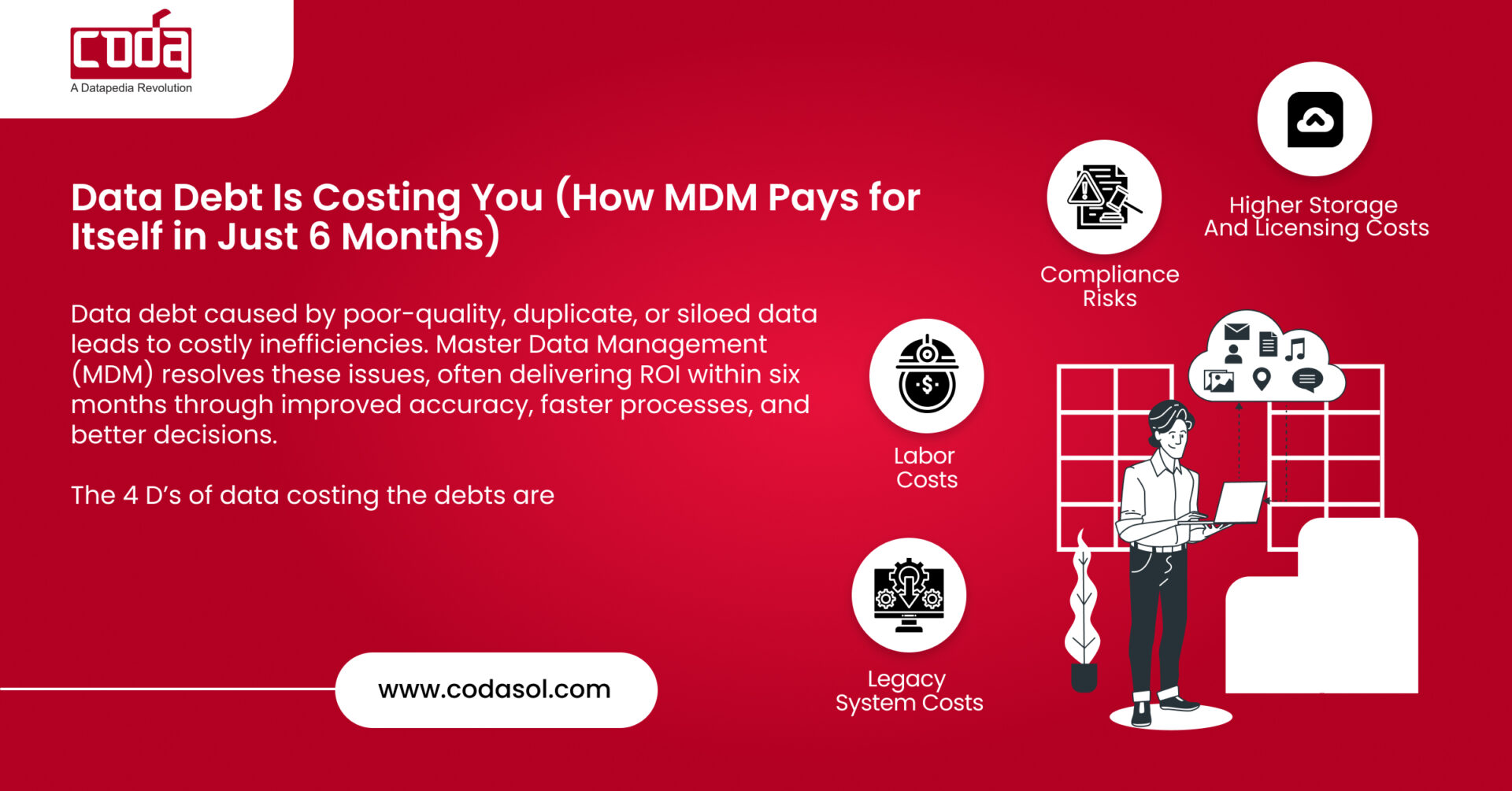Data debt is a growing challenge for businesses looking for efficiency and profitability. Poor-quality, inaccurate, and outdated data are frequently roamed within the management, resulting in higher operating expenses, inefficiencies, and missed opportunities. Expertise in Master Data Management, such as Codasol, recognizes the significant challenges and helps businesses across sectors minimize data debt, optimize processes, and realize long-term cost benefits.
What is Data Debt?
Data debt in Master Data Management refers to the gradual storage of poor-quality, unreliable, duplicate, and outdated data within the organization processed over time. Companies need appropriate data governance strategy execution, extensive time, and tireless manpower to reconcile the bad data, which turns into data debt. When data debt goes unnoticed for a long time, it impacts significant financial losses. The accumulation of data debts highly emerges from the following criteria.
The 4 D’s of Data Debt
- Dark Data
Dark data is mostly unstructured data, which is collected and stored by organizations but fails to be used or cataloged due to bad data governance, poor data management, or any other technical challenges.
- Duplicate Data
Duplicate data is typically multiple copies of the main data source across different systems. It emerged due to wrong data entry and flawed data integration within the organizations, leading to poor decision-making.
- Dirty Data
Quality data can be measured by factors like correctness, completeness, consistency, dependability, and timeliness of data. Data lacking these parameters are known as dirty data, which increase the counts of data debt.
- Decayed Data
Data that loses its quality or becomes errored over time while staying inactive in the database is called decayed data. These inactive data complicate data maintenance, create costly mistakes, and more.
The Cost of Data Debt
Data debt from various ways leads to increased operational costs and reduced productivity. Some common financial impacts include:
Higher Storage and Licensing Costs
Duplicated or incorrectly moved data greatly increases storage needs. This overflow of duplicated, irrelevant, or low-quality data has a number of financial consequences, starting with the increased expenses for on-premises or cloud storage solutions.
Compliance Risks
Inadequate data management policies lead to regulatory risks, resulting in large penalties, legal challenges, and huge expenses for corrective activities. Data debts can be reduced by prioritizing data accuracy, security, and governance.
Time-Consuming
When teams deal with poor data quality, mitigating, cleansing, and enriching the data with external sources becomes time-consuming. It results in delaying project timeframes and lessening the essence of effectiveness. Studies show that data debt takes 80% of the time just to address the right data for accurate analysis.
Labor Costs
The excessive time spent on identifying and rectifying bad data from different resources impacts the labor cost and diverts the manpower away from value-generating activities.
Legacy System Costs
Data debts in the storage systems and appliances make it hard to turn the old legacy systems into advanced data-driven tools. The outdated systems need specialized expertise and ongoing maintenance, increasing costs and limiting agility. These running costs impact financial budgeting.
These significant losses drive any organization to step into Master Data Management to save their financial costs, boost their operational efficiency, and increase their ROI with the advancement of modern tools and technology.
What is Master Data Management?
Master Data Management is the process of collecting, cleansing, enriching, standardizing, storing, and integrating qualified data across systems by creating a single unified master record.
What is a Master Data Management Tool?
A Master Data Management tool, on the other hand, is a software-based solution that helps to synchronize the organization’s master databases on the business needs.
How does Master Data Management help with Data Debt?
Improved Data Accuracy
A centralized data management approach, with effective data cleansing, is critical for ensuring data integrity and quality. The meticulous finding and deleting of duplicate, incomplete, and impure data from databases ensure only the correct and dependable data remains in the dataset.
Lower overall cost of ownership
Total cost of ownership (TCO) is the estimate of the direct and indirect expenses associated with the production and operation of a product or service, used to assess the profitability of such investments. Lower TCOs deliver more value in the long run. A flexible and model-driven Master Data Management system helps minimize the total cost of ownership for your company’s goods and services.
Reducing Process Delays
Master Data Management automates critical activities and allows you to optimize data operations while using fewer resources. It speeds up the process, minimizing delays and lowering operating expenses while saving a significant amount of time.
Risk Management
Master Data Management system protects sensitive data and tracks user activity by providing a uniform view of the organization’s database and controlling access management. All the data-related activities are controlled by data stewards, reducing the risk of data breaches and the danger of fines and penalties.
Investing in Master Data Management (MDM) can be a strategic move for organizations looking to reduce their data debt. The payback period is a critical metric that helps businesses understand how long it will take for an investment to generate enough cash flow to recover its initial cost.
Calculating the Payback Period
The payback period can be calculated using the formula:
Payback Period = Annual Cash Flow/Initial Investment
For instance, if a company invests $100,000 in an MDM solution and expects to save $20,000 annually by reducing inefficiencies and improving data quality, the payback period would be:
Payback Period = 20,000/100,000 = 5 years
Many organizations find that MDM solutions can pay for themselves much quicker than this example suggests. With proper implementation, businesses often see significant returns within six months due to:
Reduced Operational Costs
Streamlined processes lead to less time spent on data cleaning and maintenance.
Improved Decision-Making
High-quality data allows for better strategic decisions, enhancing revenue opportunities.

Ready to reduce data debts and boost your operational efficiency?
Let Codasol guide you with expert MDM solutions.
Compliance Cost Savings
By ensuring accurate and compliant data management, organizations can avoid costly fines and legal issues.
How MDM Pays for Itself Quickly
Immediate Efficiency Gains:
Organizations frequently experience immediate improvements in operational efficiency as teams spend less time managing poor-quality data.
Enhanced Data Quality:
With Master Data Management, businesses can ensure that their data is accurate, consistent, and up-to-date, leading to better analytics and insights.
Scalability:
As businesses grow, having a robust data management system allows for scalable solutions that adapt to increasing data volumes without incurring additional costs.
Wrapping Thoughts
Data debt is a critical issue that can significantly hinder an organization’s performance and profitability. By investing in Master Data Management solutions, companies not only tackle their existing data debt but also position themselves for future success.
Our data-driven MDM solutions address the underlying causes of data debt, guaranteeing that your organization may achieve demonstrable ROI in a short time. Our expertise services enhance your operational efficiency, lower compliance risks, and prepare your company for long-term development and success in an increasingly data-driven environment.

Start minimizing costs, improving efficiency, and achieving measurable ROI—often within just six months.


